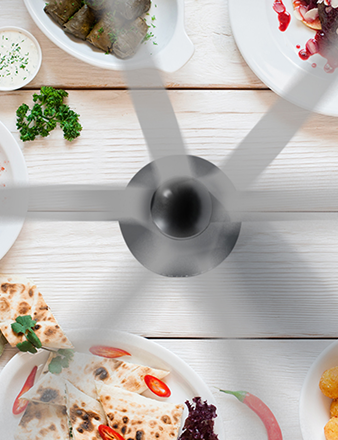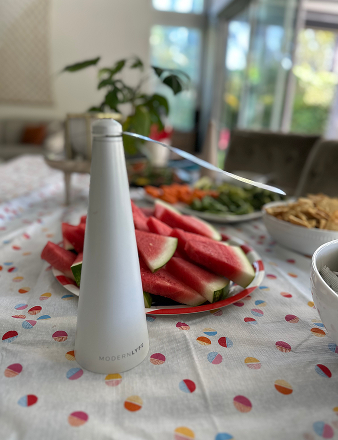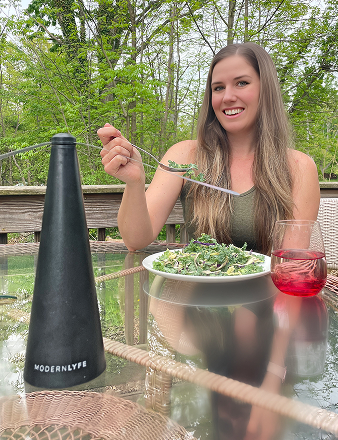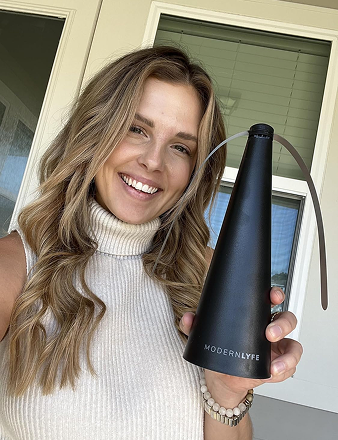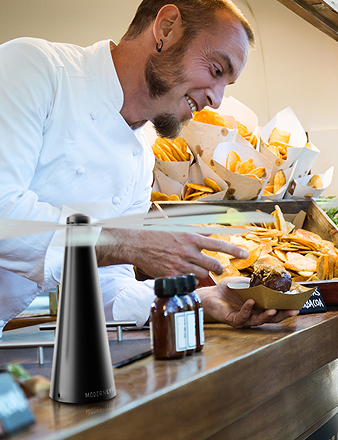To get rid of fruit flies for good, you need to be aggressive and break their life cycle. This isn’t just about swatting the flies you see; it's about systematically eliminating their food sources and breeding grounds. We're talking about more than just overripe fruit. You have to hunt down every spot where they can lay their hundreds of eggs, from sticky spills to the gunk hiding in your sink drain.
A two-pronged attack of deep cleaning and smart trapping is the only way to win.
Know Your Enemy: The Fruit Fly

It starts small. You spot one or two tiny flies buzzing around the bananas and ignore them. A few days later, a swarm has taken over your kitchen, and you're left wondering how things escalated so quickly.
The secret is their incredibly fast life cycle. A single female can lay up to 500 eggs in her short life of just a few weeks. In a warm kitchen, those eggs can hatch and grow into reproductive adults in as little as 8 to 10 days. That’s how a couple of flies turn into an infestation before you’ve even tossed the old fruit.
They Breed in Places You Haven't Considered
That browning banana on the counter is the obvious culprit, but it's rarely the only one. Fruit flies are experts at finding any bit of fermenting organic matter to call home, and modern kitchens are full of hidden breeding spots.
To gain control, you have to know where they hide. They don't just need large pieces of fruit; they thrive on the moisture and tiny food particles in places you probably don't clean daily.
Watch out for these overlooked breeding grounds:
- Sink Drains & Garbage Disposals: The thin film of organic slime lining your pipes is a five-star nursery for fruit fly larvae.
- Damp Sponges & Dishrags: If left sitting, they trap food bits and stay moist long enough for a new generation to emerge.
- Recycling Bins: The sugary residue in unrinsed soda cans, wine bottles, and juice cartons is a feast for them.
- Mop Buckets & Hidden Spills: A small puddle of standing water mixed with something sweet, like a spilled drink under the fridge, is all they need.
You can set traps all day, but if you don't eliminate the source, you'll be fighting a losing battle. They will always breed faster than you can catch them. Knowing where they thrive is half the battle.
So, How Did They Get In?
Fruit flies don’t just appear out of thin air. You usually bring them home yourself. Their tiny eggs and larvae are expert hitchhikers, catching a ride on produce from the grocery store. A single peach that’s a day past its prime could carry the start of your next infestation.
Once inside, they immediately find the nearest fermenting snack, lay their eggs, and the cycle begins.
Understanding this biology is the key to reclaiming your kitchen. Before you even think about traps or sprays, think like a fruit fly. By finding and destroying every possible food source and breeding spot, you hit them where it hurts—their life cycle. Once you’ve done that, every other method becomes infinitely more effective.
Your First Line of Defense: Prevention

When it comes to fruit flies, the best strategy is a good defense. It's far easier to make your home an unwelcome place for them before they arrive than to get rid of them after they've moved in.
Think of it as building a fortress. Your goal is to cut off everything they need to survive: food, water, and a place to lay eggs. Without these essentials, they can't establish a foothold.
Master Your Food Storage
Fruit flies have an incredible sense of smell and can detect ripening fruit from across the house. That beautiful fruit bowl on your counter? To them, it's a giant welcome sign.
As soon as produce like bananas, peaches, or tomatoes starts to ripen, move them to the fridge. The cold air slows the ripening process and neutralizes the sweet, fermenting smells they love. For produce you need to keep out, like onions and potatoes, store them in a cool, dark pantry to keep them dry.
Remember, any cut or peeled fruit is an open invitation. Eat it right away or seal it in an airtight container. The same applies to your pantry; make sure bags of sugar, flour, and other dry goods are sealed tight after opening.
Adopt Rigorous Cleaning Routines
A sparkling clean kitchen is a fruit fly’s worst nightmare. They thrive on the tiniest bits of moisture and sticky residue, often hiding in places we don't think to look.
Your new mantra is: no sticky residue left behind. This means wiping up spills from juice, wine, or anything sugary the moment they happen. Don't just give it a quick swipe—use a proper cleaning solution to break down the sugary film.
Here are a few habits that make a huge difference:
- Sinks and Drains: Rinse your sink every night to wash away food particles. Once a week, pour a cleaner down the drain and garbage disposal to clear out the gunk where they love to breed.
- Sponges and Dishrags: A damp sponge is a breeding ground. Always wring it out completely and let it air dry. Better yet, microwave it for a minute or run it through the dishwasher to sanitize it.
- Under Appliances: Crumbs and spills love to collect under the toaster, microwave, and fridge. Make a point to pull them out and clean underneath weekly.
The goal is simple: leave nothing for them. A fruit fly population can't survive without access to fermenting sugars. By keeping your kitchen meticulously clean, you're literally starving them out and breaking their life cycle.
These tiny insects cause bigger problems than you might think. The United States recently dealt with its worst fruit fly outbreak in 70 years, prompting a federal emergency allocation of $103.5 million. Globally, they cause immense economic damage, with some regions in Africa losing over $2 billion a year to these pests. This context really drives home why keeping them out of your own home is so important.
Here’s a simple checklist to help you stay on top of things.
Fruit Fly Prevention Checklist
This quick-reference guide breaks down the daily and weekly tasks that will help keep your kitchen a no-fly zone.
| Area | Daily Action | Weekly Action |
|---|---|---|
| Counters & Surfaces | Wipe up all spills immediately with a cleaning solution. | Deep clean surfaces, including under small appliances. |
| Sinks & Drains | Rinse sink thoroughly to remove all food particles. | Clean drains and garbage disposal with a specialized cleaner. |
| Food Storage | Move ripening fruit to the fridge; store cut food in airtight containers. | Inspect pantry for spills and ensure all dry goods are sealed. |
| Waste Bins | Take out trash and recycling, especially bags with food waste. | Wash and disinfect the inside of trash and recycling bins. |
| Floors | Spot clean any spills or dropped food. | Mop the floor, paying attention to corners and under cabinets. |
Making these small actions part of your routine will make a massive difference.
Implement Smart Waste Management
Your trash can is a five-star resort for fruit flies. Even with a lid, the smell of decomposing food can easily attract them, making waste management a crucial part of your prevention strategy.
First, take out the trash and recycling every single day, especially if you’ve thrown away fruit peels, food scraps, or empty soda cans. Never let it sit overnight. Before you toss cans, bottles, and jars into recycling, give them a quick rinse to remove any sweet residue.
For more tips on protecting your meals, check out our guide on how to keep flies away from food. It adds another layer of defense to keep your dining areas pest-free.
Finally, don't forget the bin itself. Clean your trash and recycling bins weekly with a good disinfectant. Sticky residue can build up on the bottom and sides, creating a hidden breeding spot.
DIY Traps That Actually Work
Sometimes, despite your best prevention efforts, a fruit fly swarm happens. When you need to go on the offense, a good DIY trap is your best tool. These traps are cheap, easy to make, and use the fruit fly’s own instincts against them.
It all comes down to simple biology: fruit flies are programmed to follow the scent of fermentation. That smell signals the ideal place to eat and lay eggs. If you can replicate that aroma, you can lure them into a trap they can't escape.
The Classic Apple Cider Vinegar Trap
There’s a reason this is the go-to method—it works. The sharp, fruity scent of apple cider vinegar (ACV) perfectly mimics the overripe fruit they're searching for. You just need a small jar, some ACV, and a drop of dish soap.
Here’s how to make it:
- Pour about an inch of apple cider vinegar into your container.
- Add a single drop of liquid dish soap. This is the secret weapon. The soap breaks the surface tension of the vinegar, so when flies land for a drink, they'll sink instead of skating on the surface.
- Gently stir the soap in. You want it mixed, not bubbly.
Set this trap wherever you see the most fruit fly activity, like near the sink or your fruit bowl. It should start working in less than an hour.
The Repurposed Wine Bottle Trick
Have an old wine or beer bottle? You've got an incredibly effective, ready-made trap. The dregs left at the bottom are already a powerful lure, and the bottle’s design does the rest of the work.
The long, narrow neck makes it easy for a fly to get in but almost impossible to navigate back out. The scent funnels up to them, they dive in, and then they're stuck.
Just leave a little wine or beer at the bottom and set it on the counter. To make it even more potent, you can add a drop of dish soap to the liquid inside.
This simple process of setting up and maintaining your traps is a cycle, as you can see here.

It’s all about mixing the right bait, placing it in the right spot, and keeping it fresh so it stays effective.
Make Your Traps Work Even Harder
Building a trap is only the first step. Placement makes all the difference in how many flies you catch.
Don't just stick one trap in the middle of the kitchen. Be strategic. Deploy a few small traps directly in the hot spots.
- By the Sink: Drains are a prime breeding ground. A trap on the edge of the sink can do wonders.
- Next to the Fruit Bowl: Intercept flies before they land on your produce.
- Near Trash & Recycling: These bins are major attractants. A nearby trap will catch flies as they come to investigate.
On a commercial scale, fruit flies are a massive threat. To control the Mexican fruit fly, the U.S. Department of Agriculture has set up quarantine zones in South Texas, with some covering up to 69 square miles. These large-scale efforts show just how quickly a small pest problem can escalate.
Expert Tip: Refresh your traps every couple of days. The bait loses its potency as it evaporates, and a trap full of dead flies can warn new ones away. A fresh trap is a working trap.
By combining a powerful attractant with a clever trap design and smart placement, you can significantly reduce the adult fruit fly population. This buys you valuable time to find and eliminate their breeding grounds for good. For more ideas, check out our guide on how to repel fruit flies to build a truly fly-free zone.
Alright, you’ve deep-cleaned the kitchen and set out your vinegar traps. That’s a great start, but traps are reactive—they catch the fruit flies that are already there.
What if you could stop them from landing on your food in the first place? This is where you move beyond trapping and start actively repelling them. Instead of messy chemical sprays, this approach uses simple physics to create an invisible force field around your food.
The Fly Fan: Your New Best Friend
A fly fan is a brilliantly simple device that just works. Take the Modern Lyfe fly fan, for example. It’s a quiet, battery-powered gadget with soft, flexible blades that spin. It’s not for cooling you down; it’s designed to disrupt a fly's world in two specific ways.
First, the spinning blades create a gentle but constant air current. Fruit flies are tiny and terrible flyers. The constant breeze from a fly fan is like a hurricane to them, creating an invisible wall they can't penetrate to get to your food. They give up and fly somewhere else.
Second, the blades have a secret weapon: a special holographic pattern. This pattern refracts light in a chaotic way that scrambles a fly's compound eyes. To a fruit fly, it’s a confusing, threatening light show they want nothing to do with.
It's All About Prevention, Not Reaction
While DIY traps are great for rounding up existing stragglers, a fly fan plays a completely different—and crucial—role. It's your preventative shield, protecting a specific zone before flies can settle in.
Imagine you're having a barbecue with bowls of fruit salad, sweet marinades, and drinks on the picnic table. You could set traps nearby, but placing a fly fan in the middle of the table creates a protected bubble around the food itself. Your meal stays fly-free and appetizing without you having to constantly wave your hands.
A fly fan doesn't kill anything. It simply makes the area so uninviting that flies won't even try to land. This shifts your entire strategy from cleanup to prevention.
The best part? It’s completely chemical-free. There are no strange smells or toxic sprays, making it perfectly safe to use around kids, pets, and right next to the food. Plus, it’s whisper-quiet, so it won’t interrupt conversations.
The Right Tool for the Right Job
To effectively control fruit flies, you need to know when to use each tool. Both traps and fans have their place, but they tackle different parts of the problem.
| Feature | DIY Vinegar Traps | Modern Lyfe Fly Fan |
|---|---|---|
| Primary Function | Attract and Kill: Lures existing flies to reduce the current population. | Repel and Prevent: Creates a fly-free zone to protect specific areas. |
| Method | Scent-based lure (smell of fermentation) and a trapping mechanism. | Air currents and visual disruption from holographic blades. |
| Best Use Case | Reducing an active infestation indoors, especially near drains or garbage cans. | Protecting dining areas, buffets, fruit bowls, and outdoor meals. |
| Safety | Mostly safe, but the liquid can be spilled and get sticky. | 100% safe with soft blades that stop on contact; no chemicals. |
| Maintenance | Needs bait refreshed every 2-3 days to stay effective. | Set-and-forget operation. Just change the batteries as needed. |
Ultimately, the most effective approach is a one-two punch. Use traps to capture the flies already in your kitchen and use a fly fan to guard your dining table or fruit bowl. By trapping stragglers and repelling newcomers, you finally get total, lasting control.
A Three-Step Strategy for Total Fruit Fly Control
Getting rid of fruit flies for good isn't about finding one "magic bullet" solution. It's a coordinated attack on three fronts: you have to cut off their food supply, eliminate the existing population, and stop new flies from gaining a foothold.
An effective plan weaves together aggressive cleaning, smart trapping, and modern repellent tech into a single strategy. This is how you solve the problem, not just reduce their numbers for a day or two.
Think of it this way: First, sanitize to destroy their home base. Next, trap to round up the adults. Finally, set up defenses to keep them from coming back.
Step 1: The "Scorched Earth" Deep Clean
Your first move must be an all-out assault on their breeding grounds. This isn’t a quick wipe of the counters; it’s a deep clean that eliminates every bit of the fermenting gunk they need to lay eggs.
Zero in on these key hotspots:
- Sinks and Drains: Pour a kettle of boiling water down the drain to dissolve the organic slime in the pipes. Follow it with a good drain cleaner and scrub the sink basin itself.
- Trash Cans: Take all garbage out of the house. Then, wash the inside of the bins with hot, soapy water to remove any sticky residue.
- Hidden Messes: This is where most people miss. Pull out your toaster, microwave, and coffee maker and clean underneath them. Check under the lip of your countertops for hidden spills.
This initial blitz is the most important step. If you take away their nurseries, you immediately stop new flies from being born, making everything else you do far more effective.
Step 2: Trapping to Thin the Herd
With their breeding grounds gone, your focus shifts to the adult flies still buzzing around. This is where simple DIY traps come in. Set out a few small cups with apple cider vinegar and a drop of dish soap.
Place them where you see the most activity. Using several small traps scattered around is much more effective than relying on one big one.
The key here is consistency. Traps deal with the flies you can see, while a spotless kitchen prevents the next generation. You can't skip one and expect the other to work.
This integrated approach is proven, even on a massive scale. For example, large-scale pest management projects in the Asia Pacific region saw incredible results. One study in Indonesia that combined sanitation with other methods saw fruit infestation on farms plummet from nearly 70% down to less than 0.2% in just six months.
Step 3: Setting Up Your Defenses
Now for the final step: protecting your food and preventing a new invasion. This is where a fly fan shines. While your traps are busy catching the stragglers, the fan creates a powerful, fly-free zone around your fruit bowl or dining table.
The gentle breeze and holographic patterns on the blades make it impossible for these weak fliers to get close enough to land. It's a simple, set-and-forget solution that creates a defensive perimeter. Even if a few flies survive your deep clean, they won't be able to get near your food. Still looking for more options? Our complete guide on the best fruit fly catcher tools can give you even more ideas.
By sticking to this clean, trap, and repel strategy, you’re not just reacting to a fruit fly problem. You're systematically dismantling their entire life cycle and creating a home where they can't thrive.
Common Questions About Fruit Fly Control

Even after cleaning and setting out traps, a few questions can pop up. When you're dealing with a persistent fruit fly problem, getting the right answers makes all the difference. Let's cover some of the most common questions.
Why Do Fruit Flies Keep Coming Back After I Clean?
This is the most frustrating part of the whole process. You’ve scrubbed the kitchen spotless, but a day later, they're back. This almost always points to a hidden breeding ground you've overlooked.
Fruit flies are incredibly sneaky. While your countertops might be sparkling, they can lay eggs in the gunk inside a sink drain, a damp sponge, or the condensation tray under your fridge. A whole infestation can be traced back to a single rotting potato hidden in the back of a cupboard.
The real issue is their life cycle. A female can lay up to 500 eggs, which mature into adults in about a week. If you miss just one spot, the population can bounce back with shocking speed. Deep, consistent cleaning of these hidden areas is the only way to break the cycle.
How Long Does It Take To Get Rid of an Infestation?
If you’re aggressive, you should see a huge reduction in adult flies in just 2 to 3 days. But to completely wipe them out—meaning you've stopped the life cycle for good—you're looking at about one to two weeks.
This timeline depends entirely on your diligence. You have to keep traps fresh to catch newly hatched flies before they can reproduce, all while being relentless about eliminating every potential food source. One lazy day can set you back to square one.
Are Store-Bought Traps Better Than DIY Ones?
Honestly, not really. Both commercial traps and homemade ones work on the exact same principle: lure and capture. A simple DIY trap with apple cider vinegar is incredibly effective because that fermented smell is a powerful, natural signal fruit flies are hardwired to follow.
While store-bought traps are convenient, a well-made homemade trap placed in the right spot is just as powerful and much cheaper. The secret isn't a fancy trap—it's strategic placement and fresh bait.
Can a Fan Really Keep Fruit Flies Away?
Yes, it absolutely can, but it’s crucial to understand how it works. A fly fan isn't a trap; it’s a preventative tool and a repellent. It creates a hostile environment that fruit flies can't tolerate.
The constant air movement from the blades makes it nearly impossible for these weak fliers to navigate and land on your food. On top of that, the holographic patterns on the blades scatter light in a chaotic way that messes with their compound eyes, disorienting them.
A fly fan is perfect for protecting a specific zone, like a bowl of fruit on the counter or your dinner table. The best approach is to use traps to eliminate the existing population and a fan to guard your food from any stragglers or new arrivals.
Ready to add a modern, chemical-free defense to your fruit fly control strategy? The MODERN LYFE fly fan creates a protected, pest-free zone around your food, making every meal more enjoyable. Protect your table today at Modern Lyfe.

